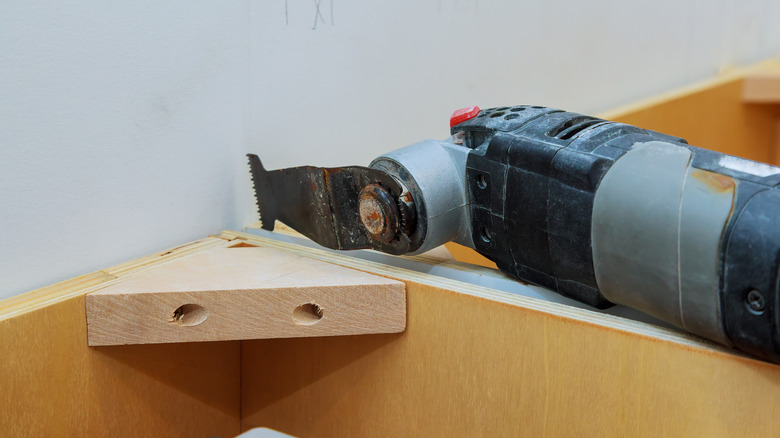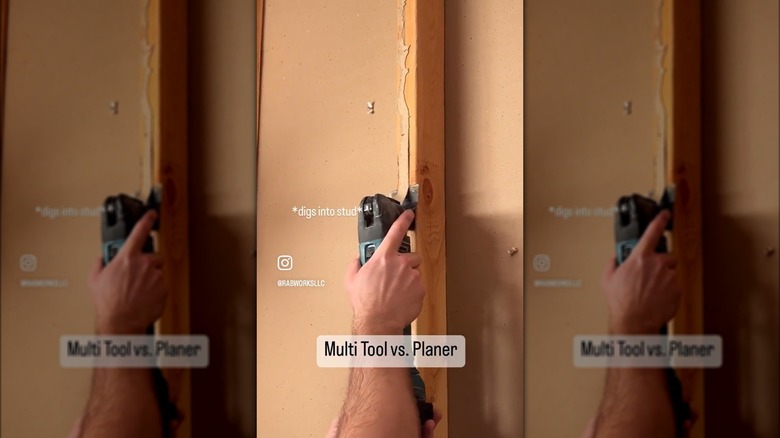TikTok's Top Tips For Using An Oscillating Tool Around The House
As a homeowner who does DIY projects occasionally, you know there are tools that every homeowner should own. If you don't have a lot of space to store tools, though, you may have interest in multi-purpose tools that can do everything you need for quick jobs, allowing you to save space. One multi-purpose device is an oscillating tool, which can handle a range of jobs for you. It is highly versatile and can do things that other tools simply can't match.
TikTok user Artpentry made a video that shows how to use the oscillating tool to cut through a board, requiring some special techniques to make sure the process goes smoothly. TikTok user Masteringmayhem shows the handiness of the oscillating tool, ranging from quickly cutting annoying plastic packaging to trimming shingles to fit and everything in between.
Ultimately, an oscillating power tool is simply one of the most multitalented machines you can have on hand at your home, as it can handle jobs from scraping to sanding to cutting to removing tile. Before you deploy it, though, it's important to understand the safest ways to use it. It runs on electric power, so you do have a risk of injury when using it. Always wear safety gear, such as gloves and protective eyewear, as splinters and other debris may fly around while using it. The blade moves side to side up to 20,000 times per minute, so it can cut your skin deeply in almost no time.
How can I use my oscillating tool to make clean cuts in my home workshop?
One of the most common uses for an oscillating tool is to make cuts in all kinds of materials at home. Many people will use it in place of saws to cut through any kind of wood. When trimming a piece of wood in the Artpentry TikTok video, the importance of making shallow cuts and letting the blade do the work is showcased. The user recommends using the oscillating tool to simply trace the groove line lightly on the first pass. Then slowly work back and forth, using the dent to guide the blade. Once you establish the groove, Artpentry then plunges the tool into the divot, going back and forth along the line, eventually creating a smooth slice.
With the right blade on the oscillating tool, you can go through almost any kind of material, you aren't just limited to cutting wood. A common use is for cutting through metal. If you have a screw that's rusted in place or a nail without a head that you cannot pull, a metal blade can cut it off at the surface. Plumbers and electricians often carry an oscillating tool, as it also slices through PVC plastic pipe, fiberglass, and drywall. It's important to match the blade to the type of cutting you want to do, though.
Learning how to use an oscillating tool to scrape and pry
If you are doing a flooring project that involves tile, the oscillating tool is a handy option for making the process go faster. Removing hardened adhesives or grout by hand is tiring work, but the power oscillating tool with its vibrating blade can simplify the job. It also works to pull up old tile, as the blade can go underneath the tile and help to pry it loose from the adhesive. Should you need to cut out some grout from between the tiles to help loosen them, the oscillating tool can help with this tough task as well.
The oscillating tool works nicely for removing excess adhesive that's dried in place, pulling it away from the unwanted surface. As TikTok user RabWorks_LLC shows, the can give you a clean contact point for mounting drywall. However, as RabWorks_LLC points out, you do have to be careful, or the oscillating tool's blade will dig into the wood framing a little bit as you move along the adhesive line if you don't have the right blade attached.
You can purchase a sanding attachment for your oscillating tool, allowing it to make use of a piece of sandpaper and taking the place of an electric sander. You even can use it to scrape paint or dried caulk, as long as you add a blade that's designed to scrape without gouging the material.


